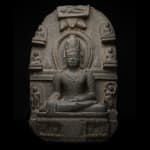Pala-Sena Buddhist Stele Depicting the Life Story of the Buddha, 1100 CE - 1300 CE
Stone
50.8 x 73.7 cm
20 x 29 in
20 x 29 in
OF.276
Further images
This is a stone stele depicting the Buddha in Pala-Sena style. Wearing an elaborate crown, the central figure Buddha Shakyamuni is seated on a lotus pedestal under the Bodhi tree...
This is a stone stele depicting the Buddha in Pala-Sena style. Wearing an elaborate crown, the central figure Buddha Shakyamuni is seated on a lotus pedestal under the Bodhi tree at Bodhgaya, indicated by the branches above his head. His facial expression is serious, since the Buddha is answering to Mara, the lord of confusion who challenges his enlightenment. Forming the Bhumisparsa mudra, the Buddha declares the earth as his witness to his enlightenment and fights of Mara. Surrounding him are scenes of his life, each one associated with a north Indian pilgrimage centre. At the lower right, the Buddha is miraculously born out of Maya’s side as she grasps a branch of a sala tree in the Lumbini gardens. At the lower left, the Buddha’s descent from Trayastrimsas heaven has been simplified to a standing Buddha. Above the two are meditating Buddhas, which symbolise other important scenes, such as fasting, teaching, and performing miracles. At the very top is the Buddha’s death at Kushinagara, marking the moment he entered nirvana. The black schist and motifs such as the elaborate throne suggest this relief may have been produced at the monastic centre of Nalanda.
During the 11th century, the Pala art style originated from Northeast India dominated artistic production, largely due to the presence of great universities in the region which invented and developed the Vajrayana tradition. Stripped of all excessive lyricism or sensuality, it testifies to the “neoclassical” Pala style. This style is internationally adopted, as its influence stretched from Tibet to Southeast Asia. This stone stele is highly polished to give it an almost metallic colour. The details are well preserved and the material is in fine condition.
Danny Ching
During the 11th century, the Pala art style originated from Northeast India dominated artistic production, largely due to the presence of great universities in the region which invented and developed the Vajrayana tradition. Stripped of all excessive lyricism or sensuality, it testifies to the “neoclassical” Pala style. This style is internationally adopted, as its influence stretched from Tibet to Southeast Asia. This stone stele is highly polished to give it an almost metallic colour. The details are well preserved and the material is in fine condition.
Danny Ching







